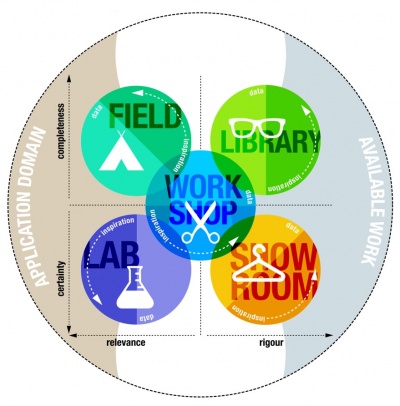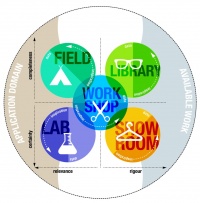Difference between revisions of "The DOT Framework"
| Line 11: | Line 11: | ||
==The DOT Framework== | ==The DOT Framework== | ||
| − | To help you in your ICT research, we advise the use of the ''Development Oriented Triangulation'' (DOT) framework ([https:// | + | To help you in your ICT research, we advise the use of the ''Development Oriented Triangulation'' (DOT) framework ([https://www.researchgate.net/publication/266684802_Design_Patterns_for_Mixed-Method_Research_in_HCI]). The DOT framework can help you to structure your research and to communicate about it. The Development Oriented Triangulation (DOT) framework consists of three levels: |
* The "What" of your research (the domains) | * The "What" of your research (the domains) | ||
* The "Why"of your reserach | * The "Why"of your reserach | ||
Revision as of 13:30, 15 February 2018
Contents
Research in ICT
As a bachelor, ICT research aims at creating an ICT product which fits it needs (in this context an ICT product can be a software product, or an ICT advise/report). The research is focused on the product, and not per se on creating new knowledge which is the aim in most scientific research.
To give you a glimpse of possible ICT research:
- investigating the stakeholders'wishes
- choosing the most appropriate technology for a (part of) ICT system
- investigating the usefulness of a certain technology or framework
- testing the quality of an ICT product
The DOT Framework
To help you in your ICT research, we advise the use of the Development Oriented Triangulation (DOT) framework ([1]). The DOT framework can help you to structure your research and to communicate about it. The Development Oriented Triangulation (DOT) framework consists of three levels:
- The "What" of your research (the domains)
- The "Why"of your reserach
- The "How" of your research (the strategies and methods)
The "What"of your research (the domains)
You can research both the specific application context of your project and the more general knowledge available that can help your project. Both types of research will help you, and are necessary to create your own "innovation", your new product/advice/report. We can express this by three domains. The first domain is the "application domain". This is the domain of the specific context that the ICT project takes place. The second domain is of "available work". All available theory, models and other artefacts that you can use is part of the available work domain. Thirdly is the "innovation domain", where your actual innovation takes place and all of the research is done.
The "Why" of your research
Explaining what you want to obtain with your research will help you to better structure your research. If you do research in the application context your reason for research will probably be to obtain a product which is relevant for the stakeholders. By doing research in the "available work" domain you will aim for an approach with high "expertise" approach. You want to assure that you use all the expertise available to create your product. You can also think more from an overview or cetainity perspective. Do you want to obtain an overview, aiming at completeness? Or do you aim more for a "certainity" perspective, assuring the quality and fit for use.
The "How" of your research (the strategies and methods)
So during a project you try to learn as much as you can about the context of available work, the application context and the innovation space. What are ways of learning these things? The DOT-Framework has 5 research strategies.
| Library |
|
Library research is done to explore what is already done and what guidelines and theories exist that could help you further your design. Since the advent of the internet library research is also called desk research. |
| Field |
|
Field research is done to explore the application context. You apply a field strategy to get to know your end users, their needs, desires and limitations as organizational and physical contexts in which they will use your product. |
| Lab |
|
Lab research is done to test your ideas with the users of your product. You use lab research to learn if things work out the way you intended them. |
| Showroom |
|
Showroom research is done to test your ideas in relation to existing work. Showing your prototype to experts can be a form of showroom research or spelling out how your product is different from the competition. |
| Workshop |
|
Workshop research is done to explore opportunities. Prototyping, designing and co-creation activities are all ways to gain insights in what is possible and how things could work. |
For each of the strategies, decide on the research method that best fits the need that you want to do. The method that you choose depends on your specfic research question and the ICT field. Each field has its own methods, from which the most important are listed here.





